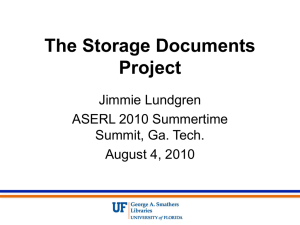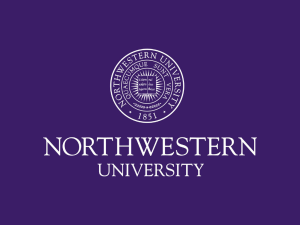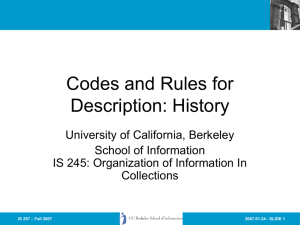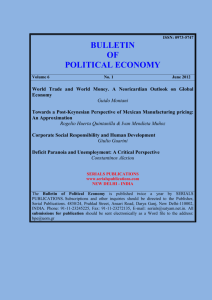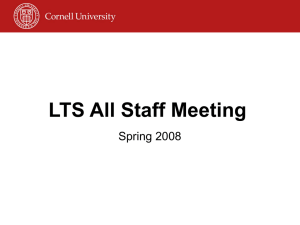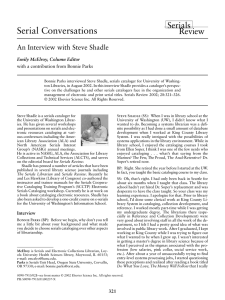Whither Technical Services?: Changes to Technical Services in the Next... Years Michael Boock Oregon State University/University of Oregon Library Faculty Summit
advertisement
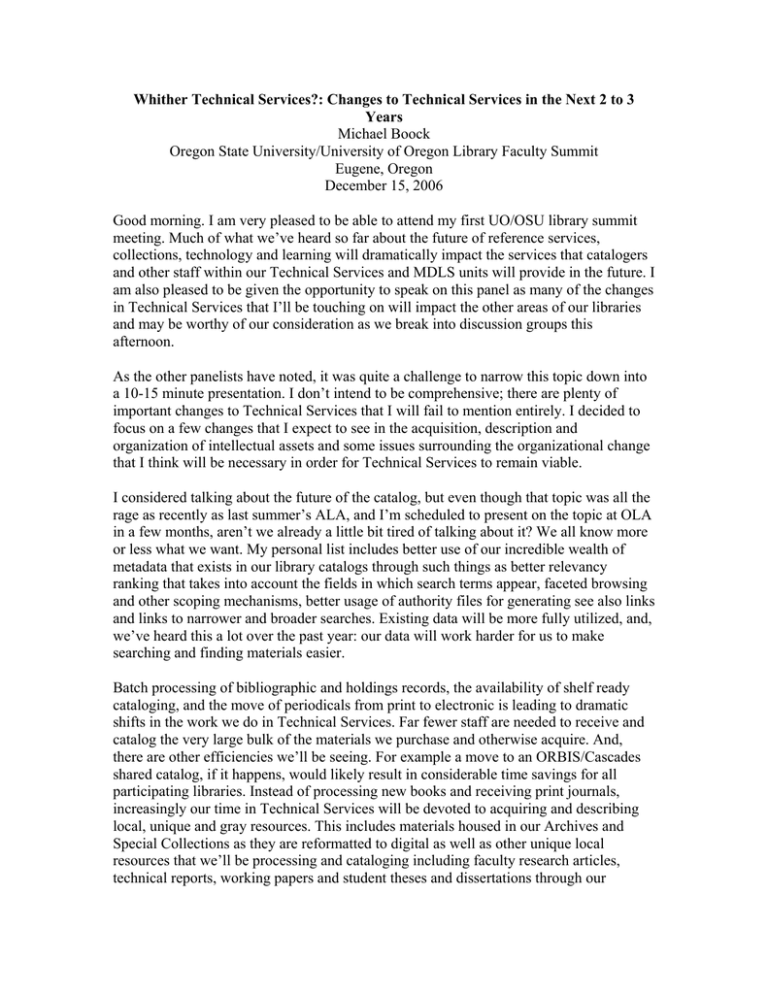
Whither Technical Services?: Changes to Technical Services in the Next 2 to 3 Years Michael Boock Oregon State University/University of Oregon Library Faculty Summit Eugene, Oregon December 15, 2006 Good morning. I am very pleased to be able to attend my first UO/OSU library summit meeting. Much of what we’ve heard so far about the future of reference services, collections, technology and learning will dramatically impact the services that catalogers and other staff within our Technical Services and MDLS units will provide in the future. I am also pleased to be given the opportunity to speak on this panel as many of the changes in Technical Services that I’ll be touching on will impact the other areas of our libraries and may be worthy of our consideration as we break into discussion groups this afternoon. As the other panelists have noted, it was quite a challenge to narrow this topic down into a 10-15 minute presentation. I don’t intend to be comprehensive; there are plenty of important changes to Technical Services that I will fail to mention entirely. I decided to focus on a few changes that I expect to see in the acquisition, description and organization of intellectual assets and some issues surrounding the organizational change that I think will be necessary in order for Technical Services to remain viable. I considered talking about the future of the catalog, but even though that topic was all the rage as recently as last summer’s ALA, and I’m scheduled to present on the topic at OLA in a few months, aren’t we already a little bit tired of talking about it? We all know more or less what we want. My personal list includes better use of our incredible wealth of metadata that exists in our library catalogs through such things as better relevancy ranking that takes into account the fields in which search terms appear, faceted browsing and other scoping mechanisms, better usage of authority files for generating see also links and links to narrower and broader searches. Existing data will be more fully utilized, and, we’ve heard this a lot over the past year: our data will work harder for us to make searching and finding materials easier. Batch processing of bibliographic and holdings records, the availability of shelf ready cataloging, and the move of periodicals from print to electronic is leading to dramatic shifts in the work we do in Technical Services. Far fewer staff are needed to receive and catalog the very large bulk of the materials we purchase and otherwise acquire. And, there are other efficiencies we’ll be seeing. For example a move to an ORBIS/Cascades shared catalog, if it happens, would likely result in considerable time savings for all participating libraries. Instead of processing new books and receiving print journals, increasingly our time in Technical Services will be devoted to acquiring and describing local, unique and gray resources. This includes materials housed in our Archives and Special Collections as they are reformatted to digital as well as other unique local resources that we’ll be processing and cataloging including faculty research articles, technical reports, working papers and student theses and dissertations through our institutional repositories. I know that Carol Hixson was aggressive here in identifying materials on campus and offering to catalog and describe them, either through the institutional repository or in the online catalog. We have also engaged with faculty and staff around campus to describe intellectual assets produced in departments. I could see Acquisitions staff becoming more involved in identifying materials on campus that are appropriate for our IRs, identifying permissions and working with faculty to gather and deposit the materials. We will increasingly be called on to assist campus constituencies with the description, organization and storage of their information, from samples of student portfolios, to digital photographs and scans of art gallery slides and artwork, to terabytes of data sets, course materials and digital photos and multimedia. A key question that I think we’ll soon need to confront is whether this work becomes a regular part of what we do or do we make the description, organization, digitization and storage of university intellectual assets a fee based service. Do we do some stuff for free and charge for other stuff? Do we serve in consultative roles and provide training in metadata and organization or do we do the work ourselves? I’ve found it interesting that since the Open Archives Initiative Protocol for Metadata Harvesting came out we haven’t seen widespread harvesting by libraries of selected metadata repositories with links to digital resources. There are plenty of examples on the macro level, for example, internet search engines harvest what they can, OAIster harvests pretty much everything that is harvestable, there is an ETD harvest site that searches across institutions ETDs and other large scale efforts, but identification and selection of harvestable sites has not yet become a part of the work of most librarians and libraries. I would not be surprised if subject librarians didn’t become increasingly involved in identifying and selecting collections of freely available digital resources for inclusion in local search tools such as our harvesting and metasearch system, LibraryFind or in subject-based portals such as Oregon Explorer natural resources digital library. Once identified and selected, catalogers would be responsible for analyzing the associated metadata and determining how that metadata is best mapped and indexed in the local portal or search tool. We should know that our patrons do not care where an item comes from or who digitized it; they just want relevant information. We’ll need to figure out workflows for accommodating this type of work. I’ve so far failed to mention the big buzzwords in cataloging such as RDA, Resource Description and Access, which is scheduled to replace AACR2 in 2009 and its focus on the FRBR principles which should enhance collocation of resources in our catalogs – another catalog improvement. Other changes in cataloging, sooner rather than later in some cases, include the use of access level records that focus on access points rather than description. We’ve seen this focus on access points over description already in the metadata we supply for digital resources using Qualified Dublin Core and CONSER is implementing the access level record for serials and integrating resources in February. I think that controlled access points will continue to be important, but there will likely be dramatic changes in subject analysis and increased reliance in our search tools on improved full text relevancy algorithms rather than controlled subject headings. We’ll increasingly be supplying geographic metadata that enables browsing and searching by geographic location. Digital curation and preservation will become increasingly important and a part of all of our knowledge bases, not just in Technical Services. I also wanted to talk briefly about the organizational change that will be necessary to enable our units to take on the many new or changed responsibilities. Over the last three years, Technical Services at OSU, and I know that we’re not unique in this, has taken on many new responsibilities without relinquishing any of the traditional responsibilities of acquiring, cataloging and preserving library materials: 1. We’ve become responsible for our I.R. systems administration and establishing data dictionaries and controlled vocabularies, working with faculty and staff throughout the university to figure out the best way to describe their materials and establishing collections of born digital resources in our IR, training staff, and promoting and marketing this service campus wide. 2. Digitization activities 3. Link resolution and all of the activities surrounding Electronic Resource Management and the maintenance of electronic holdings information. 4. Metasearch I believe that it is a necessary transition for people in Tech Services and that we must step forward to take on these new and changing responsibilities. I do believe that acquisitions and cataloging staff are uniquely equipped and skilled to take on these new roles. Tech Services staff are task-oriented and understand the management of information. We tend to be fastidious and don’t make a lot of errors. We understand how to locate and acquire and manage things and understand the organization of intellectual materials, whatever their makeup or format. Technical Services staff will be increasingly devoted to projects. Each summer and early fall acquisitions and receipts usually decrease with the new fiscal year and we engage in relatively large scale projects at OSU. In collaboration with other departments of the library we’ve done such things as recon an entire branch library’s holdings. We’ve weeded, withdrawn and moved several ranges of reference titles to make room for collaborative work space. We’ve twice moved large volumes of holdings to our storage facility, and we’ve undertaken a huge serials recon project. We’ve become increasingly agile in our Tech Services units. This agility is facilitated by increasing the efficiency with which we are able to handle many of our traditional processes, but mostly it’s the result of having good people willing to collaborate with other library staff to get important work done in a timely manner. It takes a willingness to collaborate and work outside of our traditional organizational structures and that will become increasingly important. One of the things I’m most interested in as a Tech Services administrator is how best to organize a department to accomplish these new roles and collaborative opportunities. While I haven’t always been a strong proponent of cross-training, I think it is essential that staff within Technical Services be capable of different kinds of work within Technical Services and receive appropriate training to do that work. In order to be agile, we need our paraprofessional staff to be capable of performing a wider variety of tasks. We had a serials retreat recently where we got together to talk about the massive changes we’re encountering in the move from print to electronic journals. One of the outcomes of that retreat was the recognition that staff training is necessary. We’ve developed a Technical Services training wiki and organized monthly training sessions for staff. We’ve invited BCR to present SCCTP serials workshops in February and March and will be offering Dublin Core training from CDP and LC Classification training. Our serials checkin and binding staff, in particular, are being transitioned to take on serials and electronic resources cataloging, serials recon and assisting with the IR. A large part of what our library faculty in Technical Services are responsible for is providing staff training. That will continue. I’d like to close by saying what a pleasure it has been to work with the UO since my arrival at OSU. I greatly benefited from my many conversations with Carol Hixson and have enjoyed watching all of the successes of the MDLS department. My staff have also benefited from opportunities we’ve had to meet with Faye Chadwell and her staff about III Millennium and Electronic Resource Management and I look forward to taking advantage of future opportunities for our staffs to get together. I look forward to continuing these conversations this afternoon and possibly identifying potential areas of collaboration.
